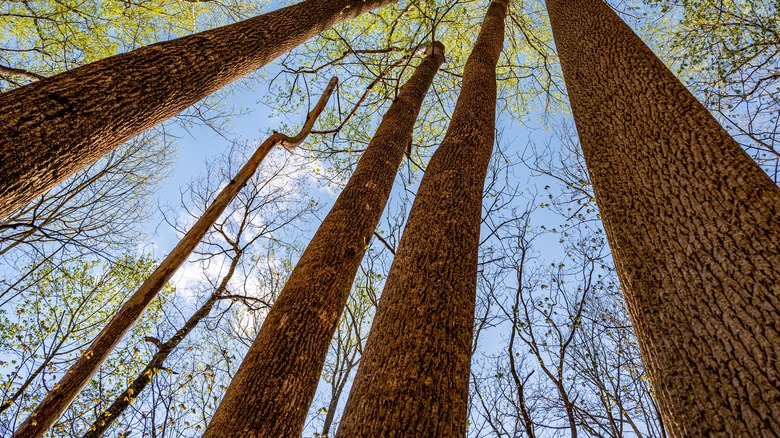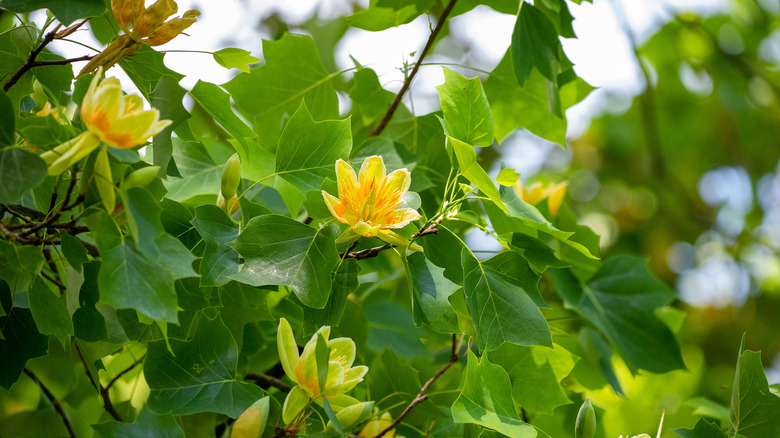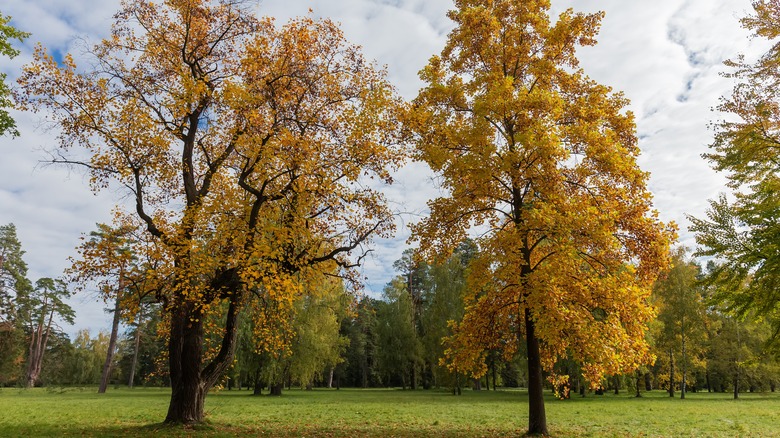The Fast-Growing Tree That Will Add A Pop Of Gorgeous Color To Your Yard
The value that trees bring to our homes, our lives, wildlife, and the planet cannot be overemphasized. Aside from their vital role in making Earth hospitable to all forms of life, they also offer a majestic, mythical, and spiritual benefit. Who doesn't have a fond memory with a tree as a child? Or even as an adult? Planting trees in your home landscape is a great way to support biodiversity, bring home wildlife, and provide immeasurable benefits to your yard via shade, gorgeous views, fruit, bird watching, and so much more. As they say, the best time to plant a tree was 20 years ago, and the second best time is today. The tulip poplar is a stunning, fast-growing tree that will bring immense value to your yard.
One thing about planting trees is that it requires patience and a steadfast belief in the future. While patience is a virtue, for those looking for the perfect fast-growing shade tree for their yard, look no further than the gorgeous and bountiful tulip poplar tree. The tulip poplar, one of the largest native hardwood trees in the U.S., grows quite fast and has an ideal growth habit with an exceptionally straight trunk. This tree also has some of the most beautiful flowers and foliage you've ever seen on a native tree.
What is a tulip poplar tree?
The tulip poplar (Liriodendron tulipifera), also known as the tulip tree or yellow poplar, is easily one of North America's most beautiful trees and one of our tallest Eastern hardwood trees. Reaching up to 200 feet tall and over 50 feet wide, the tulip poplar is a true giant of the forest. Living up to 400 years in some cases, a tulip poplar tree will continue to benefit your property for generations. The tulip tree's growth habit is to grow straight up until it reaches above the canopy and becomes the dominant tree in the area.
Interestingly enough, the tulip poplar tree is not part of the genus of poplars, and it's obviously not a tulip. The tree belongs to the magnolia family and gets its name from how its flowers resemble tulips. Furthermore, the foliage of this tree is absolutely breathtaking. Its leaves reach lengths of up to 8 inches in some cases, and their fullness and unique shape really add to the tree's ornamental value. The flowers are also unique in shape and have green, yellow, and orange coloring. However, don't get too excited about the flowers yet; tulip poplar trees will not produce flowers until about 15 to 20 years of age.
Make sure the tulip poplar tree has enough space
Since the tulip poplar is a native tree, it does not require much special care and attention in the garden. That said, it is a colossal tree, and it is not suited for small residential areas. If you intend to plant this beauty, be sure it has enough space, as it is truly one of our most enormous North American trees, and it will survive you. It is best placed in an area where its gorgeous blooms and tree shape can be admired, along with its beautiful golden-yellow fall foliage.
To set this tree up for success, it's important to consider its ideal environment. The tulip poplar thrives in full sun and is not tolerant of much shade, making it an excellent shade tree for sunny yards. It prefers slightly acidic, rich, deep, well-draining soils. Once established, it is drought tolerant. However, during dry spells, it can benefit from some supplemental watering. It does not like being too wet or dry but somewhere in the middle.
An important host plant for various butterfly and moth species, as well as a vital nectar source in the spring for all sorts of pollinators, this beauty also attracts hummingbirds! If you want to attract hummingbirds to your yard and plant a fast-growing, gorgeous shade tree, consider planting a tulip poplar.


